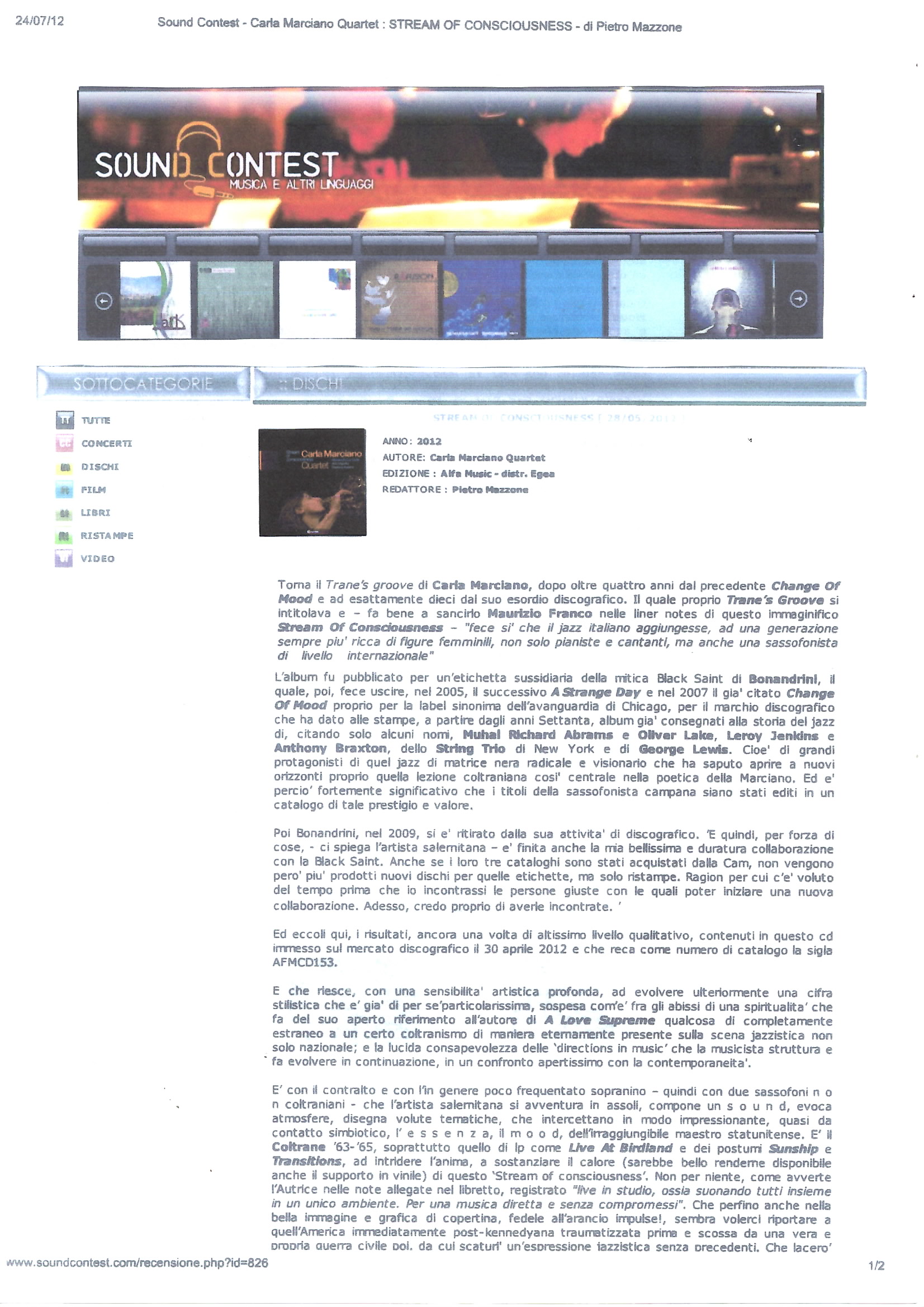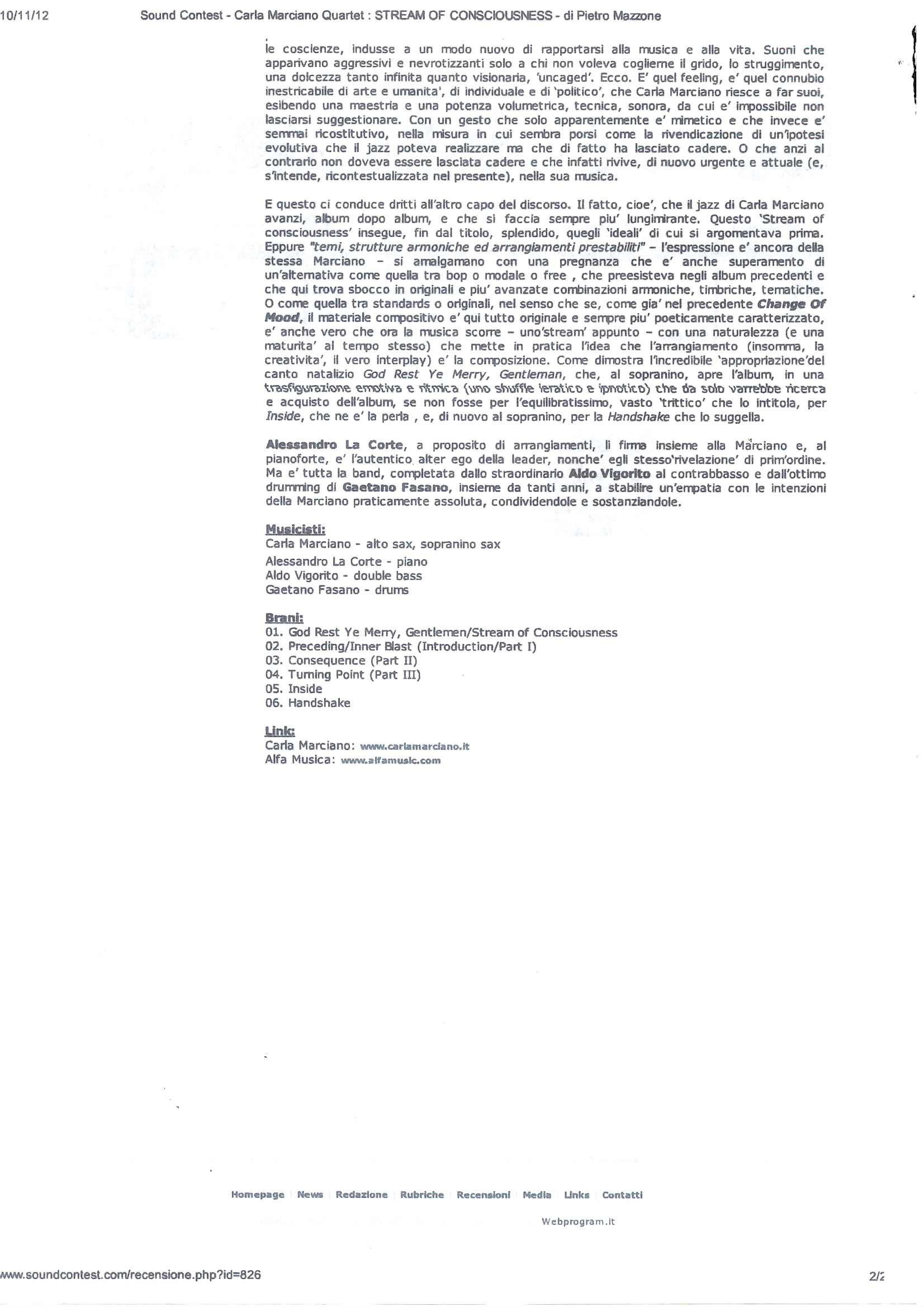Autore: Pietro Mazzone
Recensione/Review “STREAM OF CONSCIOUSNESS”


ENGLISH
Carla Marciano’s Trane’s Groove makes a comeback, after four years from the previous Change of Mood and exactly ten years from her debut album. In fact, this was actually called Trane’s Groove and – Maurizio Franco did right in officially establishing it in the liner notes of this imaginative Stream Of Consciousness – ‘making it possible’ for the Italian jazz scenario to add not only pianists and singers to a generation which is gradually becoming richer in female figures, but also a saxophonist of an international level’.
The album was released on behalf of a secondary label belonging to Bonandrini’s legendary Black Saint record company which, in 2005, also released the following album A Strange Day and in 2008, the already mentioned Change Of Mood for the very record label, synonym of the Chicago jazz avant-garde, for the record brand that had released, as from the 1970s, albums that had already written the history of jazz, of artists of the calibre of Muhal Richard Abrams and Oliver Lake, Leroy Jenkins and Anthony Braxton, of the String Trio of New York as well as George Lewis; or rather, of great protagonists of that particular jazz style relating to the black radical and visionary matrix that was capable of opening itself to new horizons such as the memory of the Coltranian lesson that plays such a significant role in Marciano’s poetics. It is therefore extremely significant that the music of the saxophonist from the Campanian region of Italy was included as part of such a prestigious and valuable album. Subsequently, in 2009, Bonandrini put an end to his career as a record producer. “And so, consequently, – the artist from Salerno explains – my wonderful and long-term collaboration with the Black Saint also finished. Even if their three albums were bought by Cam, no other new records were produced for those labels, only reproductions. So, for this reason, quite a long time passed before I met the right people with whom I could establish a new collaboration. Now, I really believe that I have finally met them’.
And these are the results, once again of the utmost quality, the contents in this cd succeed, with a profound artistic sensitivity, in further developing a style which is, in itself, truly one of its kind, suspended as if it is within the depths of a spirituality that makes of its clear reference to the author of A Love Supreme, something that is totally unrelated to a certain Coltranism, in a way that is eternally present on the jazz scene and not only on a national level; it is the lucid awareness of the ‘directions in music’ that the musician creates and which she continually allows to evolve, in a very open confrontation with contemporary trends.
It is by performing on the contralto and the generally less-known sopranino saxophones – therefore with two instruments not usually associated with Coltrane’s genre – that the musician from Salerno carries out her solo performances, she composes a particular s o u n d, she evokes atmospheres, she creates theme-based advancements which impressively capture the essence and the mood of the unequalled American maestro, almost achieving a state of complete symbiosis. It is the Coltrane of the 1963-1965 period, above all the one performing in the LP such as in Live At Birdland and the posthumously released pieces Sunship and Transitions, that pervades the soul, that generates the warmth (it would be great to make the vinyl version also available) of this ‘Stream of consciousness’. Not for nothing, as the Author of the notes inside the CD booklet states, the music is recorded “live in studio, or rather, that the musician play all together in the same environment, in order to obtain music that is direct and without any compromises “. Even the marvellous image and the graphic design of the CD cover were faithful to the orange Impulse record label!, it is as though it wants to take us back to America in the period immediately after Kennedy that was had been first of all traumatised and the subsequently shook by a downright civil war, which triggered an unprecedented jazz style which tore apart one’s consciousness, bringing about a new way in which to relate to music and to life. Sounds which seemed aggressive and neurotic only to those who chose not to capture the cries, the torment, a sweetness that is just as infinite as it is visionary, ’un-caged’. It is exactly so. It’s that kind of feeling, it’s that inextricable blend of art and humanity, of being individual and ‘political’, that Carla Marciano manages to make her own, by performing with mastery and a volumetric, technical, resonant power that is impossible not to let oneself be influenced by. By means of a gesture that seems only to be imitative and yet which, in reality, is if anything, reconstructive, to the extent that it appears to present itself as a claim for a possible evolution that jazz could have undergone but which put aside. Or rather, on the contrary, that should not have been put aside and which in fact has been brought back to life, in an urgent and up-to-date manner (meaning, re-contextualised to the present), in her music.
And this takes us right to the other end of the issue. That is, the fact that Carla Marciano’s jazz continues to make progress, album after album, and it is becoming increasingly more forward-looking. This ‘Stream of consciousness’ splendidly pursues, right from its title, those previously mentioned ‘ideals’. And yet “themes, harmonic structures and pre-established arrangements” – the expression is still that of Marciano herself – they blend with a significance that also represents the surpassing of an alternative such as that between bop or modal or free jazz, that was also present in the previous albums and which here, is employed in original and more advanced harmonic, timbric, thematic combinations. Or as in that between standards or originals, in the sense that if, as in the previous album Change Of Mood, the composition here is entirely original and it becomes increasingly more poetically characterised, it is also true that now, the music flows – an actual ’stream’ – with a naturalness (and, at the same time, a maturity) that puts into practice the idea that the arrangement (in short, the creativity, the real interplay) is the composition. As the incredible ‘appropriation’ of the Christmas carol God Rest Ye Merry, Gentleman illustrates, Carla Marciano opens the album on the sopranino sax, in an emotional and rhythmic transfiguration (a hieratic and hypnotic shuffle) for this piece alone it would be worth seeking and buying the album, yet apart from this, there is also the vast and extremely well-balanced ‘triptych’ that gives the album its title, together with Inside, the jewel of the album, and, once again Marciano takes up the sopranino sax, to perform Handshake bringing it to a conclusion.
